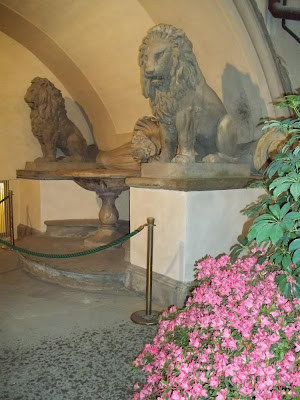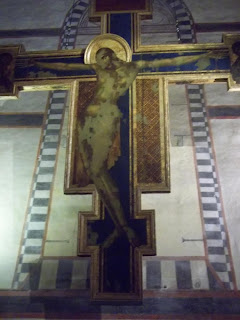May 12 & 13 - Florence...Birthplace of the Renaissance
We learned about much of the history of Italy and Florence, in particular, by wandering the streets, going into museums, and spending two days in this fantastic city.
 |
| Basilica di Lorenzo – built in 393 |
This was
the 1
st cathedral in Florence. It was completely rebuilt
in the 11
th century. It is a master of Florentine
Renaissance architecture with works of Donatelli, Filippi Lippi,
Fiorentino, Brozino, and others. Michelangelo's New Sacristy, and
the tomb of Lorenzo the Magnificent, are both housed here. This Basilica is the burial place of all the principal members of the Medici family who were the richest family in all of Italy. They spent a lot of money on the city to make it the most beautiful city in all of the world and the most powerful state in Italy. Florence became the cultural center of Europe and was known as an art center and cradle of New Humanism. The Medici Family were very interested in the rebirth of learning in Europe and under their patronage, the Renaissance flourished.
 |
| One of the monumental gates that survived - 13th century walls in Florence |
 |
| The Basilica di Santa Maria del Fiore or Il Duomo di Firenze - 1296 - 1436 |
This was absolutely incredible, especially climbing up into the dome and seeing the mosaic decor.

 |
| "The Last Judgement" |
 |
| Some of the paintings were actually quite scary! |

 |
| The steps were STEEP! |
 |
| The interior of the Cathedral |
 |
| Michelangelo's famous "Pieta" is housed in St. Peter's Basilica - LONG lines so didn't make it | |
Basilica di Santa Croce - the largest Franciscan church in the world. It was begun in 1294. Inside Santa Croce are the tombs of notables such as
Galileo Galilei, Niccolò Macchiavelli, Lorenzo Ghiberti, Giorgio Vasari, and
Michelangelo Buonarroti. There is also an elaborate monument to
Dante Alighieri, one of Florence's more celebrated citizens.
 |
| Basilica di Santa Croce |
The Statue of Liberty has a precursor
in the Basilica di Santa Croce. The Florentine Statue represents the
liberty of poetry and thus the freedom of art and creativity in
general. She differs from her distant American cousin in her more
feminine form, in the gentle grace of her pose.

 |
| Baroncelli Chapel |

The next few pictures I think are helter skelter and out of order, but realize that there is so much to see in Florence and since I'm so behind in my blog, I will just post them and hopefully you can get a "taste" of the art and culture and amazing history that we saw. We took scores of more pictures, too. I don't dare post some because the monuments were sculpted many times with the characters having no clothes on. That was Roman art!









 |
| This famous portrayal of Christ was nearly destroyed by a terrible flood |
 |
| Does anyone want to describe this scene? |
 |
| The emotion here is amazing |
 |
| I LOVE this sculpture! |
 |
| See the locks even on Ponte Vecchio Bridge |
 |
| Ponte Vecchio from afar |


 |
| Ari, one of our CS friends at Leo's Place went with us around the city |
Pinocchio" is a classic of children's literature and Italy's second most
read book after Manzoni's "The Betrothed." It was written by Tuscan
writer Carlo Lorenzini under the pen name of C. Collodi and was first
published in Rome in 1881. Hewas born in Florence in 1820. All the children of the world are familiar
with this little hero, the naughty wooden puppet who walks and talks -
and whose nose grows longer and longer every time he tells a lie.
I found the cutest shop of Pinocchio items and so many things telling of the guy who makes them. You can find Pinocchios everywhere in Italy, so I was curious as to the birth of this character.
The characters in "Pinocchio" are vivid and remain with us for along
time. For instance, Jiminy Cricket is
the conscience of the puppet. The Blue Fairy is Collodi's mother.
Geppetto is the self-sacrificing father. "Pinocchio" comprises a web of
metaphors about the conditions of man. It also depicts class struggles
and comments on social injustice and on the contrast between poor and
rich.
Translations of this famed story have appeared in more than two hundred languages and dialects.
In 1940, Walt Disney adapted "Pinocchio." It was his second movie, after
"Snow White." Although the original plot had to be simplified and pared
down, the movie was fairly faithful to the original story.

















































No comments:
Post a Comment